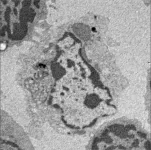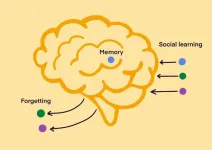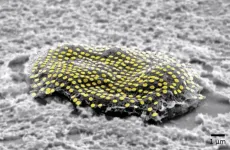(Press-News.org) HOUSTON – (Aug.7, 2023) – The spinal cord is harder to access and study than even the brain. The challenges posed by its mobility and anatomical structure have made understanding exactly how it functions difficult.
Rice University engineers will work with collaborators to optimize an array of nanoelectronic threads, or NETs ⎯ already used successfully for gathering high-fidelity, long-term data from neurons in the brain ⎯ for use in the spine, supported by a $6.25 million, four-year grant from the National Institutes of Health.
In addition to neuronal activity recordings, NET probes can provide tunable, localized stimulation of adjacent neurons. Rice neuroengineers also hope to maximize NETs' functional bandwith by integrating them into a larger-scale, data-processing system.
The new tool could help neuroscientists crack the secrets of spinal cord function and bring new hope to patients dealing with injuries and other associated medical conditions.
“So far, we haven't had a good understanding of how the neurons in the spinal cord actually work,” said Chong Xie, the principal investigator on the grant and an associate professor of electrical and computer engineering and neuroengineering. “For example, if you move your arms or walk around, you have the intention in your brain and the muscles operate exactly as you want them to. This conversion of the initial intention into specific motions of each of the muscles is operated and implemented in the spinal cord, where circuits consisting of many, many neurons are responsible for carrying out this job. But we don't know exactly how this is achieved.”
Using electrodes to track neuronal activity in the brain has allowed neuroscientists to learn a great deal about brain function. The flexible NET probes developed by Xie and collaborators integrate seamlessly with brain tissue and perform better than rigid probes when used to record electrical information from individual neurons in the brain.
Preliminary tests have shown that NET probes can achieve high-quality, long-duration recordings from spinal cord neurons of mice. However, the scientists intend to further adapt NETs to the specific structural and functional demands of the spinal cord.
In the brain, the distribution of neurons, or gray matter, and the bundles of nerve fibers known as white matter is the exact inverse of spinal cord anatomy.
“We typically refer to this as the ‘inside-out anatomy’ of the spinal cord,” said Lan Luan, an assistant professor of electrical and computer engineering and co-investigator on the grant. “The outer layer of the brain ⎯ the gray matter ⎯ is where the neurons are, whereas the fibers called white matter are on the interior. In the spinal cord, the white matter or fibers are on the exterior, shielding the neurons. This makes accessing those neurons more challenging.”
To ensure better access, scientists plan to develop a probe design that is small enough to be implanted at different sites on the spine yet has greater depth coverage and enough channels to capture data from neurons in a spinal cord cross section.
Another goal is to equip the probes with stimulation capabilities in addition to their recording function.
“The electrode can do both,” Luan said. “This has a direct health relevance, because for patients with spinal cord injury or other types of injuries, stimulation could be a way to restore fine motor control. There are several very successful technologies demonstrating that stimulation in the cord can restore local motions. But to impact finer motor control, we believe we need to go inside the cord and have a greater degree of access and precision for applying this stimulation.”
The spinal cord plays a significant role in pain processes, so identifying which spinal neurons are directly involved with pain-signal relay could open the door to better pain-management therapies.
“Identifying the specific type of spinal neurons that play a significant role in processing pain information could potentially enable the development of drugs that target precisely those cells,” Xie said. “Or maybe we can use the electrodes to stimulate those neurons and modulate their activity so that they don’t convey the pain signal to the brain.”
Scientists plan to not only optimize probe design, but also to incorporate spinal NETs into an extremely miniaturized, integrated data-processing and stimulation-feedback system.
In addition to developing the technology, Xie, Luan and their team have partnered with the Pfaff lab at the Salk Institute for Biological Studies, the Weber lab at Carnegie Mellon University and the Basbaum and Ganguly labs at University of California, San Francisco for a series of spinal cord studies that will test the devices across different spinal regions, animal models and research topics.
Luan said she hoped that developing and optimizing NET-based technology for spinal cord research would “provide a tool that can help the entire neuroscience community achieve a more fundamental understanding of spinal cord function.”
“My real hope is that, four years down the road, at the end of this project, neuroscientists will be able to see and do new things that are impossible with current technology,” Xie said.
-30-
This release can be found online at news.rice.edu.
Follow Rice News and Media Relations via Twitter @RiceUNews.
Award information:
Award number: U01NS131086-01
Title: “Optimizing ultraflexible electrodes and integrated electronics for high-resolution, large-scale intraspinal recording and modulation”
Image downloads:
https://news-network.rice.edu/news/files/2023/04/230330_NIH-U01-Grant-Chong-Xie-Lan-Luan_1_LG.jpg
CAPTION: Chong Xie (left) is the principal investigator on the grant and an associate professor of electrical and computer engineering and neuroengineering at Rice. Lan Luan is an assistant professor of electrical and computer engineering and co-investigator on the grant.
(Photo by Gustavo Raskosky/Rice University)
Related stories:
Engineers explore the source of dreams and thoughts:
https://news.rice.edu/news/2022/engineers-explore-source-dreams-and-thoughts
Gentle probes could enable massive brain data collection:
https://news.rice.edu/news/2020/gentle-probes-could-enable-massive-brain-data-collection
Blood flow recovers faster than brain in micro strokes:
https://news.rice.edu/news/2020/blood-flow-recovers-faster-brain-micro-strokes
Links:
Luan lab: https://www.luanlab.net/
Xie lab: https://www.chongxie.net/
Rice Neuroengineering Initiative: https://neuroengineering.rice.edu/
Rice Integrated Systems and Electromagnetics Lab (Chi group): https://chilab.info
Department of Electrical and Computer Engineering: https://eceweb.rice.edu
Located on a 300-acre forested campus in Houston, Rice University is consistently ranked among the nation’s top 20 universities by U.S. News & World Report. Rice has highly respected schools of Architecture, Business, Continuing Studies, Engineering, Humanities, Music, Natural Sciences and Social Sciences and is home to the Baker Institute for Public Policy. With 4,552 undergraduates and 3,998 graduate students, Rice’s undergraduate student-to-faculty ratio is just under 6-to-1. Its residential college system builds close-knit communities and lifelong friendships, just one reason why Rice is ranked No. 1 for lots of race/class interaction and No. 4 for quality of life by the Princeton Review. Rice is also rated as a best value among private universities by Kiplinger’s Personal Finance.
END
Tiny, flexible spinal probe system could lead to better therapies
Rice U. scientists win NIH grant to advance spinal cord research
2023-08-07
ELSE PRESS RELEASES FROM THIS DATE:
Advancing environmental justice research and student engagement in energy
2023-08-07
HOUSTON, Aug. 7, 2023 – The Baker Hughes Foundation announced a $100,000 grant to the University of Houston Energy Transition Institute (ETI) to support environmental justice research and workforce development programs.
The institute, which focuses on the creation and use of reliable, affordable, environmentally responsible energy for all through a just and equity-driven pathway, is looking forward to using the grant to amplify its mission.
“Thanks to the generous support of the Baker Hughes Foundation, the UH ...
Carbon dioxide – not water – triggers explosive basaltic volcanoes
2023-08-07
ITHACA, N.Y. – Geoscientists have long thought that water – along with shallow magma stored in Earth’s crust – drives volcanoes to erupt. Now, thanks to newly developed research tools at Cornell, scientists have learned that gaseous carbon dioxide can trigger explosive eruptions.
A new model suggests that basaltic volcanoes, typically located on the interior of tectonic plates, are fed by a deep magma within the mantle, stored about 20 to 30 kilometers below Earth’s surface.
The research, which offers a clearer picture of our planet’s deep internal dynamics and composition, with ...
Inside job: Finding exposes unexpected killer of immune cells lacking self marker
2023-08-07
Researchers at Kobe University discovered an entirely new and unexpected mechanism by which the immune system can get rid of cells lacking molecules that identify them as part of the self in mice. The finding, published in PNAS, has possible implications for cancer treatment.
The immune system comprises many types of cells that work together to fight off diseases. Two important types are dendritic cells and T cells. Dendritic cells are located in strategic positions throughout the body including the gut and skin, as well as in the lymph nodes, sample their environment and present small components derived from these samples on their ...
Memory, forgetting, and social learning
2023-08-07
Social learning is typically thought to be most beneficial when the environments in which individuals live change quite slowly – they can safely learn tried and tested information from one another and it does not go out of date quickly. Innovating brand-new information, on the other hand, is thought to be useful in dynamic and rapidly changing environments.
Researchers Madeleine Ammar, Laurel Fogarty and Anne Kandler at the Max Planck Institute for Evolutionary Anthropology developed an agent-based simulation model of the evolution ...
New method to identify mutations in childhood brain tumors
2023-08-07
Researchers at Uppsala university have developed a new method to find mutations in brain tumors in children. They could also show that the mutations identified by them changes how cancer cells respond to a cancer drug. These findings could lead to better diagnostics and more individualized treatment of children with brain tumors. The study is published in the journal PNAS.
Medulloblastoma is the most common malignant brain tumor in children. It usually develops in the cerebellum and even if modern treatment has improved the prognosis so that over 70% live more than five years, not all patients ...
Climate influences the spread of a life-threatening zoonotic disease in the Amazon
2023-08-07
Outbreaks of polycystic echicnococcosis, a life-threatening zoonotic disease, are driven by regional climate changes, according to a study led by the Barcelona Institute for Global Health (ISGlobal), an institution supported by “la Caixa” Foundation. The findings, published in PNAS, provide evidence of the impact of climate on neglected tropical diseases in the Amazon region, with implications for other zoonoses.
Polycystic echinococcosis (PE) is a neglected life-threatening zoonosis caused by an intestinal worm (Echinococcus vogeli) ...
Research discovers key cause of restricted blood flow to the brain in vascular dementia
2023-08-07
Groundbreaking new research has uncovered a potential route to developing the first ever drug treatments for vascular dementia, that directly target a cause of the condition. The research, funded by the British Heart Foundation and published in the journal Proceedings of the National Academy of Sciences, [1] has shed light on how high blood pressure causes changes to arteries in the brain, a process that leads to the devastating condition.
High blood pressure is a main cause of vascular dementia, a condition characterised by poor blood flow to the brain. The reduced blood supply starves brain cells of nutrients and over time they become damaged ...
Latest in body art? ‘Tattoos’ for individual cells
2023-08-07
Engineers have developed nanoscale tattoos—dots and wires that adhere to live cells—in a breakthrough that puts researchers one step closer to tracking the health of individual cells.
The new technology allows for the first time the placement of optical elements or electronics on live cells with tattoo-like arrays that stick on cells while flexing and conforming to the cells’wet and fluid outer structure.
“If you imagine where this is all going in the future, we would like to have sensors to remotely monitor and ...
Georgia State Researcher awarded $3.6 million grant to help address mental health crisis in schools
2023-08-07
ATLANTA — Catherine Perkins, a clinical professor in the College of Education & Human Development at Georgia State University, has been awarded a five-year, $3.6 million grant by the U.S. Department of Education to expand quality school-based mental health (SBMH) services for underserved populations in high-need schools.
The Expanding Quality SBMH Services for Underserved Populations with Inclusive Practices (GSU-EQUIP) grant will have a direct impact in metro Atlanta by increasing access to school-based programs and strengthening the candidate pool of mental ...
Current estimates of Lake Erie algae toxicity may miss the mark
2023-08-07
COLUMBUS, Ohio – There is more to a harmful algal bloom than the green stuff in water that meets the eye – specifically, a changing hazard level of toxins produced by the microbes that make up the scummy mess.
A new study analyzing toxins produced by Microcystis, the main type of cyanobacteria that compose the annual harmful algal bloom (HAB) in Lake Erie, suggests that the toxicity of the bloom may be overestimated in earlier warm months and underestimated later in the summer.
The research is part of a large project, led by The Ohio State University, designed to develop a more accurate harmful algal bloom toxicity forecast ...
LAST 30 PRESS RELEASES:
Making lighter work of calculating fluid and heat flow
Normalizing blood sugar can halve heart attack risk
Lowering blood sugar cuts heart attack risk in people with prediabetes
Study links genetic variants to risk of blinding eye disease in premature infants
Non-opioid ‘pain sponge’ therapy halts cartilage degeneration and relieves chronic pain
AI can pick up cultural values by mimicking how kids learn
China’s ecological redlines offer fast track to 30 x 30 global conservation goal
Invisible indoor threats: emerging household contaminants and their growing risks to human health
Adding antibody treatment to chemo boosts outcomes for children with rare cancer
Germline pathogenic variants among women without a history of breast cancer
Tanning beds triple melanoma risk, potentially causing broad DNA damage
Unique bond identified as key to viral infection speed
Indoor tanning makes youthful skin much older on a genetic level
Mouse model sheds new light on the causes and potential solutions to human GI problems linked to muscular dystrophy
The Journal of Nuclear Medicine ahead-of-print tip sheet: December 12, 2025
Smarter tools for peering into the microscopic world
Applications open for funding to conduct research in the Kinsey Institute archives
Global measure underestimates the severity of food insecurity
Child survivors of critical illness are missing out on timely follow up care
Risk-based vs annual breast cancer screening / the WISDOM randomized clinical trial
University of Toronto launches Electric Vehicle Innovation Ontario to accelerate advanced EV technologies and build Canada’s innovation advantage
Early relapse predicts poor outcomes in aggressive blood cancer
American College of Lifestyle Medicine applauds two CMS models aligned with lifestyle medicine practice and reimbursement
Clinical trial finds cannabis use not a barrier to quitting nicotine vaping
Supplemental nutrition assistance program policies and food insecurity
Switching immune cells to “night mode” could limit damage after a heart attack, study suggests
URI-based Global RIghts Project report spotlights continued troubling trends in worldwide inhumane treatment
Neutrophils are less aggressive at night, explaining why nighttime heart attacks cause less damage than daytime events
Menopausal hormone therapy may not pose breast cancer risk for women with BRCA mutations
Mobile health tool may improve quality of life for adolescent and young adult breast cancer survivors
[Press-News.org] Tiny, flexible spinal probe system could lead to better therapiesRice U. scientists win NIH grant to advance spinal cord research



